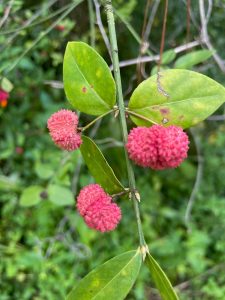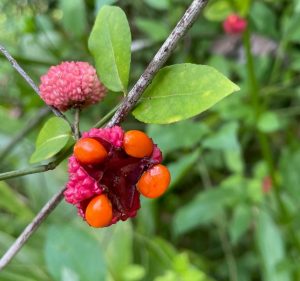
Over the weekend, I drove through Magnolia Springs, Alabama, just over the state line in Baldwin County. It is a charming little area, and the only place in the country where many residents receive their mail year-round via postal boat. Riverfront mailboxes are mounted on piers along the Magnolia River, as the water was easier than traversing rural roads in the town’s early history.
The town was built near the headwaters of Magnolia Spring, and a local garden club has planted a small arboretum on a paved pathway down to the spring. Native trees and shrubs were carefully maintained along the trail. Admiring the plants, I found myself completely drawn to a tall shrub with bright red nubby seedpods. While I’d heard of the plant before, I have never actually seen one in a landscape. This eye-catching shrub Euonymous americanus is known as a strawberry bush (the fruit looks much like a strawberry), or “hearts-a-bustin’,” as the opening fruit reveals bright reddish-orange seeds like a Valentine bursting with color.

The plant is native to a wide swath of the United States, from Texas all the way up to southern Canada. In Florida, it grows throughout the upper 2/3 of the state, preferring shady areas like sloping woodlands and the outer floodplains of creeks and rivers. It will grow in a wide variety of soil types, from sand to clay. The leaves do turn reddish in the fall, providing some rare color in the north Florida woods.
Wildlife feed on the plant—particularly birds, small mammals, and deer—but all parts of the plant contain mild toxins and are unsafe for human consumption. Interestingly, a European relative of the American species has a tie to the old foktale of Sleeping Beauty. The heroine of the story entered her long sleep after pricking her finger on a knitting spindle, which in the old days was constructed of Euonymous wood. Due to its toxic properties, the plant was widely believed to induce comas (which it does not).
Hearts-a-bustin’ is an excellent choice for home landscapes, particularly one where the goal is to attract wildlife. The autumn leaves and unusual fruit color and shape add lots of interest to a garden.
 9
9
